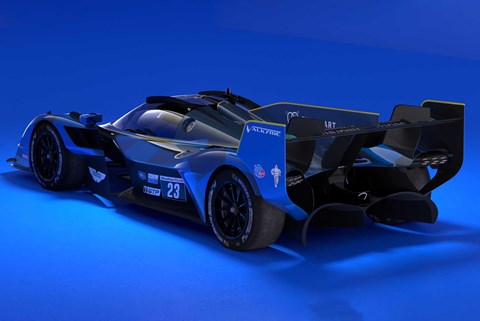► Race version of V12-engined Valkyrie ditches hybrid
► Competing in US and global series, starting this month
► Up against 2024 winners Ferrari; Ford and Genesis joining soon
This is the racing version Aston Martin’s Valkyrie, which will be competing at this summer’s Le Mans 24 Hours and in the whole World Endurance Championship and US IMSA series this year, kicking off with WEC round one in Qatar at the end of February.
Adam Carter, Aston’s head of endurance motorsport, says: ‘For people who’ve grown up in racing, going racing with Aston Martin is a great privilege. To be able to do it with the Valkyrie, at a time when sportscar racing is in a golden era of manufacturer interest, is a great opportunity, the stars aligning.’
The Valkyrie is the only car in the Hypercar class that’s derived from a road-legal car, and the only V12. It keeps the Cosworth-built 6.5-litre naturally aspirated V12 engine, but loses the limited-edition road car’s hybrid assistance, as that adds weight and contributes more power than WEC rules allow to be used. The racer makes about 670bhp, against the road car’s 100bhp-plus, with valvetrain revisions giving a smoother torque delivery.
It’s competing for overall victory against a packed field that includes 2024 winners Ferrari, previously dominant Toyota, and works-backed cars from Peugeot, Alpine, Cadillac, Porsche and BMW. Genesis has said it’s joining the series in 2026, and Ford has announced it plans to join in 2027.

Aston Martin will run two Valkyries in WEC (pictured in green) and one in the IMSA series (in blue, which now uses the same regulations as WEC). The WEC cars will be driven by Marco Sorensen, Alex Riberas and Brits Tom Gamble and Harry Tincknell. The US car is in the experienced hands of Ross Gunn and Roman de Angelis. All three cars will take part in the high-profile Le Mans race, which Aston has been involved with since 1928. In recent years its main success has been in the GT3 class. This year will be a serious attempt to nab its first overall victory since 1959.
Aston Martin CEO Adrian Hallmark says: ‘The Valkyrie is an embodiment of our enduring sporting ethos, one that has defined the brand for more than a century.’
The roadgoing Valkyrie was in large part the work of Adrian Newey. He’s now with Aston Martin’s F1 team, but hasn’t been directly involved in the Le Mans project. Various details have been tweaked to adhere to racing rules and to make it better suited to the demands of 24-hour racing – the aerodynamics, for instance, are no longer active, but the underbody has remained close to the road car’s.
The big change is removing the hybrid element from the V12 engine. Carter says that in race form the engine will not be working so hard as it does in road spec, which should help with reliability, durability and fuel efficiency.
He says: ‘Running lean to reduce the amount of fuel you are carrying to deliver the required stint energy is important. We operate the engine slower than it’s capable of because we require less power. The lower power limit within the regulations creates an opportunity for us to revisit the torque curve and reduce the frictional losses by reducing engine speed to increase fuel efficiency.’
He adds: ‘You learn every time you go to the racetrack. Feeding that learning back into Aston Martin is an important part of what we do.’